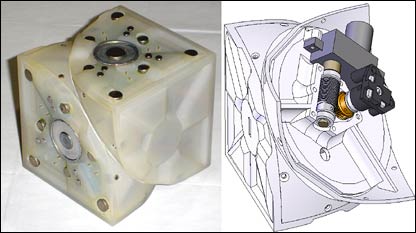US robot builds copies of itself
2005 05 13
By Roland Pease | BBC

Electrical contacts let each cube communicate with its neighbours |
US researchers have devised a simple robot that can make copies of itself from spare parts.
Writing in Nature, the robot's creators say their experiment shows the ability to reproduce is not unique to biology.
Their long-term plan is to design robots made from hundreds or thousands of identical basic modules.
These could repair themselves if parts fail, reconfigure themselves to better perform the task they have been set, or even to make extra helpers.
So far, the robots, if they can be called that, consist of just three or four mobile cubes.
Each unit comes with a small computer code carrying a blueprint for the layout of the robot, electrical contacts to let it communicate with its neighbours, and magnets to let them stick together.
By turning and moving, the cubes can pick up new units, decide where they belong, and stack them alongside each other to make new devices.
In a little more than a minute, a simple three-cube robot can make a copy of itself.
That offspring version can then make further copies. It is only a toy demonstration of the idea, but lead researcher Hod Lipson, of Cornell University in Ithaca, New York, has bold plans for these intelligent modular machines.
"Space applications clearly come to mind. If you're sending a robot to one of Jupiter's moons, and the robot breaks, then the mission is over," Dr Lipson told the BBC.
"So you would like to have a robotic system that can adapt, or to repair itself, remotely. So that would be one clear application."
Other applications could be down mines or in nuclear facilities. The researchers have previously used aspects of evolution to help them design robots.
Combining this with the biology of self-repair and of replication would make huge changes to the field of robotics.

The modular robotic cubes contain electromagnets that selectively weaken and strengthen, enabling the robot break and join links. The growing cube assemblies are supplied with extra cubes at two "feeding" locations. A three-module robot can replicate itself in just over a minute. |
Article from: http://news.bbc.co.uk/2/hi/science/nature/4538547.stm

|
